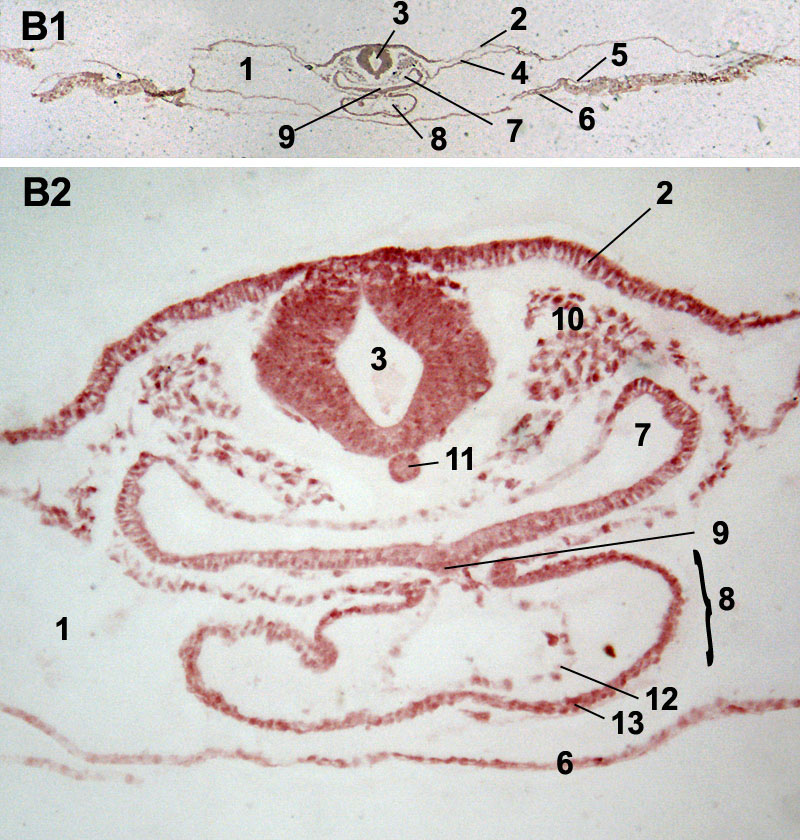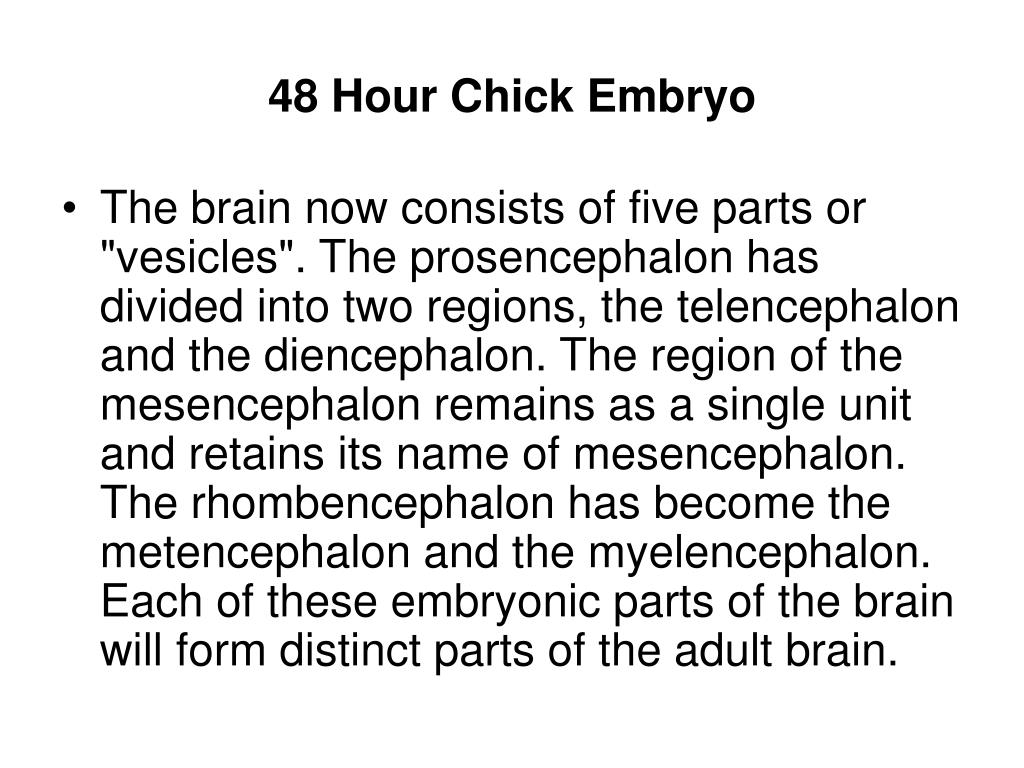On this page the following view of the embryology in chicken are displayed:
Through the trunk region of 48 hours chick embryo with lateral body fold Neural tube. Cross Section of the 72 Hour Chick Embryo through the head and heart. Of 48 Hours Chick Embryo of 26-28 Pairs of Somites: 1. Of 48 hours chick embryo. At this stage the area opaca and area pellucida are not visible. The extra embryonic area has grown in size. Primitive streak has disappeared. The mesoderm, in front of Hensen’s node, has given rise to 26-28 pairs of somites. Intarmed 2025 BIO 130 Trans 03 01 48 Hour Chick Embryo Page 23 of 24 Never from BIO 23 at University of the Philippines Manila.
48 Hour Chick Embryo Serial Cross Section Chart
72 Hour Chick Embryo Labeled
Stage 48 hrs| Whole mount preparation 48 hrs | |
|---|---|
| Information: The position of the embryo with respect to the yolk changes strongly about 48 hours after fertilization. In addition to the head fold of the amnion, also the lateral and caudal amniotic folds begin to form. The outgrowth of the cranial flexure is so strong that the forebrain and hindbrain vesicles become almost located to each other. The cephalic region of the embryo is twisted in such a manner that the left side comes to lie next to the yolk. A second flexure appears at the transition of the head and the body just behind the heart region. The embryo takes now the shape of a C. The head becomes covered by a double fold. These folds definitely establish the first extra embryonic membrane (=outside of the embryo): the amnion membrane. The vitelline (yolk rich) arteries and veins become connected with the extra embryonic circulatory vessels. A few branchial grooves are already visible. The brain divides in to 5 vesicles: telencephalon and diencephalon (both formed by the division of the forebrain vesicle), mesencephalon, metencephalon and myencephalon (both formed by the division of the hindbrain vesicle). The lens placode (placode=plate) will form the lens vesicle, the optic vesicle will become the optic cup and the auditory placode the auditory pit. The heart differentiates in to 4 compartiments: the sinus venosus, connected with the veins, the atrium, the U-shaped ventricle and the bulbus cordis. The atrium and ventricle are well distinguishable in the figure. | |
| Embryology in chicken 48 hours after fertilization: stained whole-mount preparation 1 Amnion, 2 Metencephalon, 3 Mesencephalon, 4 Optic cup + lens, 5 Prosencephalon, 6 Otic vesicle, 7 Branchial arches, 8 Atrium , 9 Ventricle, 10 Lateral fold, 11 Lateral mesoderm, 12 Vitelline arteria / vein, 13 Somite, 14 Spine, 15 Tail fold | |
| Cross section chicken embryo - 48 hours | |
|---|---|
| A. Ear and eye formation: left whole mount and right cross section (dorsal part oriented to the left here) | |
| 1 = Myencephalon, 2 = Otic vesicle, 3 = Chorda, 4 = Pharyngeal cavity, 5 = Pharynx, 6 = Optic vesicle, 7 = Lens placode (lens formation), 8 = Optic cup, 9 = Diencephalon | |
| a, b, c, d : schematical representation of the eye formation overtime; e and f: detail of sections 1 = Neurectoderm, 2 = Epidermal (surface) ectoderm, 3 = Mesoderm, 4 = Optical vesicle, 5 = Optical cup, 6 = lens, lp = Lens placode (lens formation) | |
| B. Heart formation: left whole-mount preparation and right cross section (dorsal part oriented to the left) | |
| 1 = Spine, 2 = Somite differentiation (sclerotome dermamyotome), 3 = Chorda, 4 = Dorsal aorta arches, 5 = Cranial cardinale vein, 6 = Pharynx, 7 = Pericardial cavity, 8 = Heart formation | |
| C. Heart formation: left wholemount preparation and right cross section (dorsal part oriented left) | |
| 1 = Spine, 2 = Dermatome, 3 = Chorda, 4 = Dorsal aorta, 5 = Foregut, 6 = Truncus arteriosus, 7 = Atrium, 8 = Ventricle, 9 = Heart region |

Stage 55 hrs
| Dextro dorsal view at 55 hrs according to Patten |
|---|
| Patten, B.M. (1920). The Early Embryology of the Chick. Philadelphia: P. Blakiston's Son and Co. |
Another Way To Look at Serially Sectioned Frog and Chick Embryos
48 Hour Chick Embryo Serial Cross Section Picture
What we show here is the first part of a project we call '4-D Embryology--Embryos in Three Dimensions and Their Changes Over Time.' We captured digital images of all the sections of serially sectioned embryos. We then used the sequence of images of an embryo to make a QuickTime digital movie. After we made movies of several serially sectioned frog and chick embryos, we started using them in our developmental biology labs. Students like watching and using these QuickTime movies to learn about developing embryos, and we want to share these movies with other students of developmental biology. What you can see here are small 'postage-stamp' versions of these movies of serially sectioned frog and chick embryos. All show sequential cross sections going anterior-to-posterior (head-to-tail). Get Quicktime- Serially Sectioned Frog Embryo Movies
- 4 mm 5 mm
- 7 mm 10 mm
- Serially Sectioned Chick Embryo Movies
- 24 hr 33 hr 33 hr
- 48 hr 48 hr 56 hr
48 Hour Chick Embryo Cross Section
If you want to use these movies in your classes, you can download the full-size QuickTime movies of these embryos. To download these movies, you need to be a member of the SDB. If you're not a member, join the SDB--it really doesn't cost that much to join and it's a great organization to belong to. Anyway, e-mail me, Laurie Iten (laurie_iten@sdb.bio.purdue.edu), if you want to know how and where to download these movies.Why We Look At Serial Sections of Embryos
When we study embryology, we need to visualize the changes that occur in developing embryos. Direct observation is the ideal method for visualizing developing embryos. Everyone enjoys watching living embryos develop or watching time-lapse movies of developing embryos. Some embryos remain transparent throughout their development and we can see what's going on inside and outside at the same time. Most embryos are not transparent; once they become more than a few cell layers thick, we only see what's happening on the outside.To see what's going on inside, we typically cannot dissect an embryo because it's too small. We have to look at serial sections of embryos. Serial sections are where we slice an embryo as if it was a sausage. We affix each section, in order, on a microscope slide and stain the sections before we look at them with the microscope. We then 'read' these two-dimensional sections to try to visualize the three-dimensional organization of all the layers and parts of an embryo at one stage of development.
The above three figures are modified versions of Fig. A, p.3 of Schoenwolf, G.C. 1995, Laboratory Studies of Vertebrate and Invertebrate Embryos. Guide and Atlas of Descriptive and Experimental Development. 7th Edition, Prentice Hall, New Jersey.

How We Make the Movies
To capture images of sections to make into movies, we use a compound microscope with a video camera attached to a computer (Macintosh) with a video board.Within an image editing application (Photoshop), we capture an image of each section of a serially sectioned embryo.We also use Photoshop to align images before we make the movies.
To make the movie, we used the QuickTime 'Convert to Movie' application.

What Else Is Being Done in the '4-D Embryology' Project
'Flying' through a QuickTime movie of a serially sectioned embryo gives us a hint of the three-dimensional (3-D) spatial arrangement of embryonic structures. Now we are taking the 2-D images we used to make the movies to reconstruct an embryo into its natural three dimensions. What you see below are some 'slices' through a reconstructed 7 mm frog embryo.When we have embryos reconstructed at consecutive stages of development, we'll be able to look at the spatial arrangement of the cells, tissues, and organs as they appear over time--the fourth dimension of embryology.
Contributed by Laurie Iten
Purdue University
3/9/96